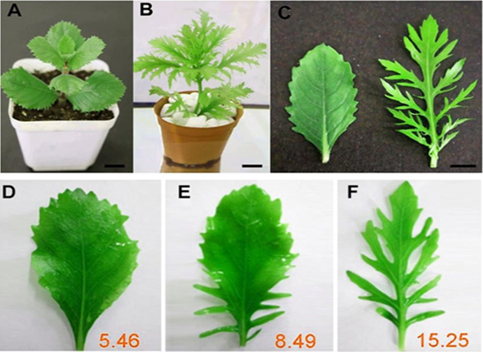
Newsroom
An Ideal Plant Found for Study of Heterophylly
Heterophylly refers to the considerable difference in leaf form that can occur in response to environmental changes. The phenomenon occurs in some plants that thrive near the water and are sometimes submerged by flooding, and can grow both under water and in terrestrial conditions. Many environmental factors and phytohormones are known to be involved in the process. However, due to the lack of an ideal model plant, the regulatory mechanism remains to be elucidated.
A research group at Institute of Hydrobiology (IHB) of Chinese Academy of Sciences, recently found an ideal plant for the study of heterophylly, after growing and screening a number of heterophyllous plants. Ranunculus aquatilis was found to be too large to grow in a laboratory, Callitriche heterophylla and Myriophyllum spicatum did not have very obvious leaf morphology differences, and it was hard to set up a stable gene transformation protocol for Rorippa aquatica.
The group found, however, Hygrophila difformis (Acanthaceae) was a good model plant for the study of heterophylly. The plant is easily propagated and maintained under laboratory conditions (10-30cm in height), showing clear and well-defined heterophyllic responses to both environmental and hormonal changes. It is genetically tractable due to a small genome(about 800 Mb) and easy transformation.
The group has established standardized protocols of propagation, tissue culture, leaf shape analysis, callus induction and Agrobacterium-mediated transformation. On the basis of these methods, through the analysis of interactions between environmental factors, hormones and gene expression, an initial regulatory framework of heterophylly has been established. These findings lay a foundation for revealing a more detailed regulatory mechanism.
This study was recently published online first in “Plant Cell Reports” with the title “Water-Wisteria as an ideal plant to study heterophylly in higher aquatic plants”.

A: A plant grown in a terrestrial environment. B: A plant grown in a submerged environment. C: Terrestrial leaf (left) and submerged leaf (right). Bars = 1 cm. D-F: Three leaves with different form complexity. Red numbers indicate leaf form complexity as estimated by the “dissection index (DI)”, calculated as (leaf periphery)/√(leaf area). (Image by IHB)

G-I: Vegetative reproduction of H. difformis. G: Cuttage propagation from terrestrial stems. H: Regeneration of submerged leaf fragments. I: Regeneration of terrestrial leaf fragments. Bars = 1 cm. J-L:GUS staining of leaves from a plant transformed with TCS::GUS report construct. Bars = 1 mm. G: A photomicrograph showing chromosomes within a root tip cell of H. difformis (2n = 32). Bar = 25μm. (Image by IHB)